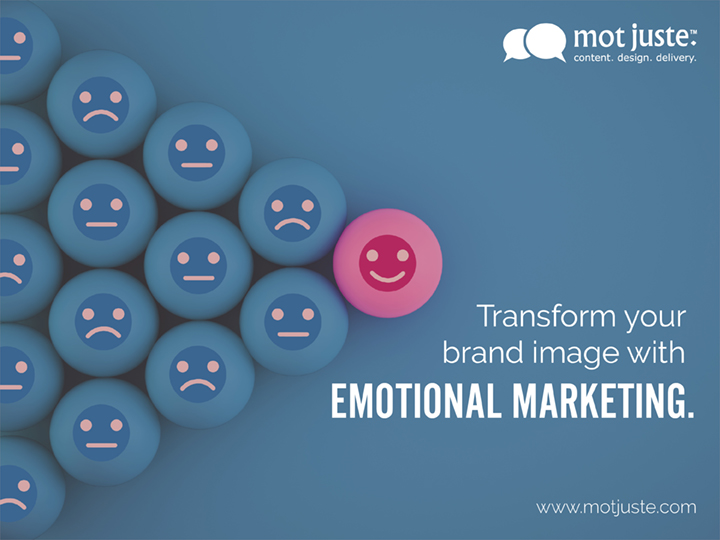
Emotional marketing does exactly what its name suggests – it markets a product (or a service, or a brand) to the emotions of the potential consumer. It involves sending out a message, through any marketing medium, that connects with the targeted audience in a personal way.
What does that mean? Well, when you highlight your product’s features and their benefits, when you show statistics or give a list of quantitative and qualitative reasons why purchasing your product is a wise choice, you are appealing to your audience’s logic. On the other hand, if you are influencing the audience’s decision to buy your product by addressing their deepest values, interests or passions, then you are appealing to their emotions.
What’s wrong with marketing to the logic?
Absolutely nothing… but studies reveal that, more often than not, it’s emotions that greatly influence and even determine our decisions!
That’s why a consumer’s emotional response to an ad is far more likely to influence his/her intent to purchase than the actual content of the ad itself. The impact of emotion in response to television commercials is three times greater than that of logic, and two times greater in response to print ads. This is not just for products; when it comes to how consumers perceive a brand and how much they “like” a brand, they use their emotions, personal feelings and experiences rather than logic or information.
So how do you approach emotional marketing?
1. Tell your brand story
One of the most thoughtful ways to connect with your audience is by telling your story. Your story will help people to see the human face (or faces!) behind your brand, not just a logo or a product or any other inanimate association.
Talk about the brand’s history, what led to its creation, the challenges you faced and overcame. Add a narrative, show the real faces, and instantly make your way into the hearts and minds of your audience. Celebrating brand milestones is another way to build connections between your customers and your brand. You can also use storytelling to start conversations and improve engagement across different platforms which, in the long run, can build a loyal tribe for your brand.
Another advantage is that stories are up to 22 times more memorable than facts. So before you craft your brand story, know what you want your brand to be remembered for. Then, weave an engaging story around that message!
2. Evoke positive feelings
In the world of emotional marketing, happiness and other positive emotions encourage more shares. Aim to hit the “happy” part of the audience’s brain to improve your brand’s reach and visibility. Market the right positive message to a small audience and allow them to “organically” reach out to a larger audience for you. You might even manage to kick-start a viral campaign if you do it right!
Emotional articles receive the most shares and positive posts get more attention than negative ones, according to this study. And one such positive emotion that has the power to transform the way your audience views your brand is love. A message wrapped in love humanises even the most mundane of products and the brands that sell them.
You can also consider using nostalgia, to take your audience along a walk down memory lane. Research shows that the mind can summon emotional memories – of events that caused joy, pride, love, excitement and so on – which can be triggered to create a satisfying emotional “experience”. Even as the world moves forward in leaps and bounds, thanks to technology, if your ad can slow things down or turn back time to take your audience to a former “happy place”, you are a winner!
3. Evoke negative feelings
Yes, emotional marketing works just as well with negative emotions as it does with positive. However, the purpose and expected outcomes from this kind of emotional marketing are different. While happiness and other positive emotions compel your audience to share, negative emotions improve engagement. In the world of emotional marketing, sadness leads to higher click-through rates (CTR). Ads whose headlines contain words with negative connotations are 63% more likely to get clicked, in comparison to ads that have positive words.
For that matter, it’s not just sadness, but other negative emotions like anger, fear, and disgust that work well in emotional marketing. However, they must be used wisely and with caution. It may go without saying, but don’t provoke your audience just for the sake of it! If you really have a reason to evoke a negative emotion which can make a positive impact, then go ahead!
The purpose of this kind of emotional marketing is often to shake people out of their traditional mindsets, the rut of routine, or numbness that they may have developed towards important issues. Anger may be used to bring injustice to light, fear can be used to create a sense of urgency. Emotional marketing, in this manner, can be used to share social messages and give people the push they need to take a certain action.
4. Boost their ego
Don’t flatter your audience excessively, but help them feel good about themselves! A great example of this kind of emotional marketing is to send out messages that say they are – as L’Oreal puts it – “worth it”. The secret is to tell them they deserve the best. The subtle undertone of the message is, of course, that you are the best!
Appeal to the self-esteem of your audience, tell them that black is beautiful in a world that insists on fairness, create a sense of body positivity in a world that is used to body shaming, tell them it’s perfectly OK to not be perfect. Make them feel smart, bold, sophisticated. The idea is to communicate like a friend and, in the long run, take the place of one.
Another way to go about this is by evoking a sense of belonging. Turn your brand into an ambassador of the nation, connect with your audience on the “local” level. People automatically relate to and feel a certain sense of patriotism and ownership when they know the brand that is from the same soil as themselves.
5. Send out an inspiring message
An inspiring message may not necessarily inspire immediate sales, but it does build a positive brand image! Brands use well-known personalities as spokespersons to create an aura of aspiration. Ask them to talk about how they overcame challenges to rise to where they are today. However, if you are unable to afford a public figure for your ads, don’t waste your money. Use unknown faces to remind your audience that even ordinary people are capable of great things!
Another way to inspire your audience and build your brand image is by showing them what you, as a company, do outside of selling your products. You probably use a sustainable method in your manufacturing process, you may be doing something good for the environment, or your employees could be volunteering at a charity. All of these are ways to touch your audience, show them your sensitive, human side, and inspire them to take up such initiatives too.
If your company or brand is using a method to manufacture products without harming the environment, or giving livelihood opportunities to village artisans or the underprivileged, for example, then people may even be inspired to switch to your brand! We all have the innate urge to do good, and your audience will understand that, just by purchasing from you, they are participating in an activity that contributes to the greater good.
+1. Finally… keep it real!
These five emotional marketing strategies are just a few of the many successful ways to market your brand to your audience’s emotions. If you get creative enough, you can find unique and wonderful ways to win hearts with your campaigns.
Regardless of the strategy you choose, remember to stay authentic. Take your audience seriously, value their emotions and don’t treat emotional marketing as just another way to make some money. Your audience can easily see when an ad is “faking it”, resulting in it being turned into a meme. Don’t give the world an opportunity to make a mockery of your brand! Put your heart into your own emotional marketing and make a genuine effort. Your audience will become loyal, long-term customers and even brand evangelists in their respective social circles!
